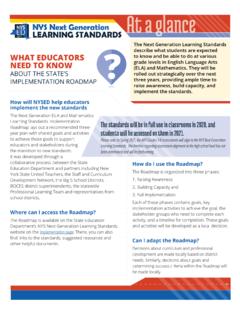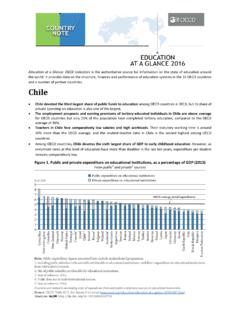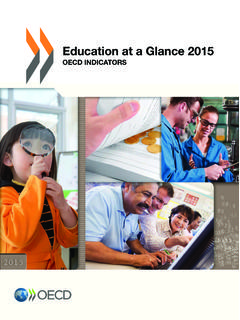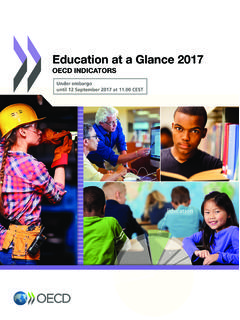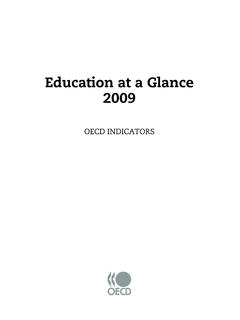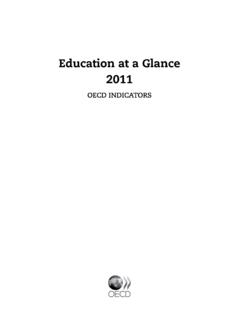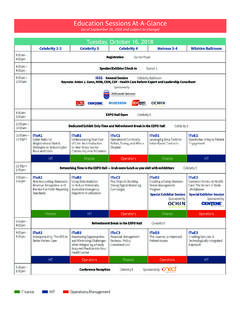Transcription of Education at a Glance 2013
1 Consult this publication on line at work is published on the OECD iLibrary, which gathers all OECD books, periodicals and statistical for more at a Glance 2013 HIGHLIGHTSE ducation at a Glance 2013 HIGHLIGHTSE ducation at a Glance 2013: Highlights summarises the OECD s fl agship compendium of Education statistics, Education at a Glance . It provides easily accessible data on key topics in Education today, including: Education levels and student numbers: How far have adults studied, and how does early childhood Education affect student performance later on? Higher Education and work: How many young people graduate from tertiary Education , and how easily do they enter the world of work? Economic and social benefi ts of Education : How does Education affect people s job prospects, and what is its impact on incomes?
2 Paying for Education : What share of public spending goes on Education , and what is the role of private spending? The school environment: How many hours do teachers work, and how does class size vary? Each indicator is presented on a two-page spread. The left-hand page explains the signifi cance of the indicator, discusses the main fi ndings, examines key trends and provides readers with a roadmap for fi nding out more in the OECD Education databases and in other OECD Education publications. The right-hand page contains clearly presented charts and tables, accompanied by dynamic hyperlinks (StatLinks) that direct readers to the corresponding data in Excel 978-92-64-20106-496 2013 04 1 P-:HSTCQE=WUVU[Y: Education at a Glance 2013 HIGHLIGHTS2013 Education at a Glance2013 HIGHLIGHTSThis work is published on the responsibility of the Secretary-General of the OECD.]
3 Theopinions expressed and arguments employed herein do not necessarily reflect the officialviews of the Organisation or of the governments of its member document and any map included herein are without prejudice to the status of orsovereignty over any territory, to the delimitation of international frontiers and boundariesand to the name of any territory, city or 978-92-64-20106-4 (print)ISBN 978-92-64-20107-1 (HTML)Series: Education at a GlanceISSN 2076-2631 (print)ISSN 2076-264X (online)The statistical data for Israel are supplied by and under the responsibility of the relevant Israeli authorities. The useof such data by the OECD is without prejudice to the status of the Golan Heights, East Jerusalem and Israelisettlements in the West Bank under the terms of international credits:Cover Blue Jean images/Getty : Chapter1 Jeffrey Coolidge/The Image Bank/Getty 2 Wavebreakmedia 3 Tom Grill/Photographer s Choice RF/Getty Julia Smith/Riser/Getty 5 Image Source/Getty to OECD publications may be found on line OECD 2013 You can copy, download or print OECD content for your own use, and you can include excerpts from OECD publications, databases andmultimedia products in your own documents, presentations, blogs, websites and teaching materials, provided that suitableacknowledgment of the source and copyright owner is given.
4 All requests for public or commercial use and translation rights should besubmitted Requests for permission to photocopy portions of this material for public or commercial use shall beaddressed directly to the Copyright Clearance Center (CCC) the Centre fran ais d'exploitation du droit de copie(CFC) cite this publication as:OECD (2013), Education at a Glance 2013: Highlights, OECD AT A Glance 2013: HIGHLIGHTS OECD 20133 ForewordEducation at a Glance 2013: Highlightsoffers a reader-friendly introduction to the OECD scollection of internationally comparable data on the name suggests, it is derived fromEducation at a Glance 2013, the OECD s flagshipcompendium of Education statistics. However, it differs from that publication in a number of ways,most significantly in its structure, which is made up of five sections that explore the following topics: Education levels and student numbers:This section looks at Education levels and trends inthe general population, early childhood and secondary Education systems.
5 Higher Education and work:This section looks at how many students enter and successfullycomplete tertiary Education , as well as young people s transition from school to the world of work. The economic and social benefits of Education :This section looks at the extent to whicheducation brings economic gains to individuals, in the form of higher incomes and lowerunemployment rates, and at how these benefits serve as an incentive for people and societies toinvest in Education . It also examines the societal benefits related to having a highly educatedpopulation. Paying for Education :This section looks at how much countries spend on Education , the role ofprivate spending, what Education money is spent on and whether countries are getting value formoney. The school environment:This section looks at how much time teachers spend at work, andhow much of that time is spent teaching, class sizes and teachers general, this publication uses the terminology employed inEducation at a Glance , in one or two places terminology has been simplified.
6 Readers who want to find out moreshould consult the Reader s and charts in this volume are accompanied by a dynamic hyperlink, or StatLink, that willdirect readers to an Internet site where the corresponding data are available in ExcelTMformat. Inaddition, reference is sometimes made in the text to charts and tables that appear inEducation ata Glance 2013. This material can generally be accessed via the StatLinks accompanying the tablesand charts in the relevant indicator, or at wishing to find out more about the OECD s work on Education should go OF CONTENTSEDUCATION AT A Glance 2013: HIGHLIGHTS OECD 20135 Table of contentsExecutive 7 Reader s 91. Education levels and student 13 Towhat level have adults studied?.. 14 Who participates in Education ?.. 16 What is the role of early childhood Education ?
7 18 How many young people finish secondary Education ?.. 202. Higher Education and 23 Howmany young people enter tertiary Education ?.. 24 How many young people graduate from tertiary Education ?.. 26 How many students fail to graduate?.. 28 How successful are students in moving from Education to work?.. 30 How many students study abroad and where do they go?.. 323. The economic and social benefits of 35 Howmuch more do tertiary graduates earn?.. 36 How does Education affect employment rates?.. 38 What are the incentives to invest in Education ?.. 40 What are the health benefits of Education ?.. 424. Paying for 45 Howmuch is spent per student?.. 46 What share of national wealth is spent on Education ?.. 48 What share of public spending goes to Education ?.. 50 What is the role of private spending?
8 52 How much do tertiary students pay?.. 54 How much do teachers cost?.. 565. The school 59 Howlong do students spend in the classroom?.. 60 How many students are in each classroom?.. 62 How much are teachers paid?.. 64 How much time do teachers spend teaching?.. 66 Statistical 71 Further 75 Look for the StatLinks2at the bottom of the tables or graphs in this book. To download the matching Excel spreadsheet, just type the link into your Internet browser, starting with the prefix, or click on the link from the e-book OECD Publications on:This book service that delivers Excel files from the printed page! OECDA lertsEXECUTIVE SUMMARY: Education AND SKILLS IN THE MIDST OF THE CRISISEDUCATION AT A Glance 2013: HIGHLIGHTS OECD 20137 Executive summary: Education and skillsin the midst of the crisisBetween 2008 and 2011 unemployment rates climbed steeply in most countries coveredin this edition ofEducation at a Glance : Highlightsand have remained high ever since.
9 Youngpeople have been particularly hard-hit by un- and underemployment as a result of theglobal recession. In 2011, the average proportion of 15-29 year-olds neither in employmentnor in Education or training (NEET) across the OECD was 16%; among 25-29 year-olds, 20%were NEET. In some countries the figures are much higher, with more than one in threepeople between the ages of 25 and 29 neither in Education nor in young peopleare forced to pay a very high price for a crisis that was not of their making, with long-lasting effects on their skills, work morale and social good Education is still valuableEducational attainment has a huge impact on employability and the crisis onlystrengthenedthis impact. On average across OECD countries, of individuals with atertiary degree were unemployed in 2011, while of those lacking a secondaryeducation were.
10 Between 2008 and 2011 the unemployment gap between those with lowlevels of Education and those with high levels of Education widened: across all age groups,the unemployment rate for low-educated individuals increased by almost percentagepoints, while it increased by only percentage points for highly educated young people, a good Education provides valuable insurance against a lack of workexperience, even during a crisis: across OECD countries, an average of of 25-34 year-olds without secondary Education were unemployed in 2011, compared with of 55-64year-olds. Among 25-34 year-olds with a tertiary qualification, , on average, wereunemployed, compared with of 55-64 year-olds with a similar level of many factors play a role in a country s capacity to contain the rise in youthunemployment in times of crisis, the way institutional arrangements between educationand work facilitate transitions into employment is perhaps one of the most that have a higher-than-average (32%) proportion of graduates from vocationalprogrammes, such as Austria, the Czech Republic, Germany and Luxembourg, were all ableto keep the increases in unemployment rates among this age group to below 8 percentagepoints.
